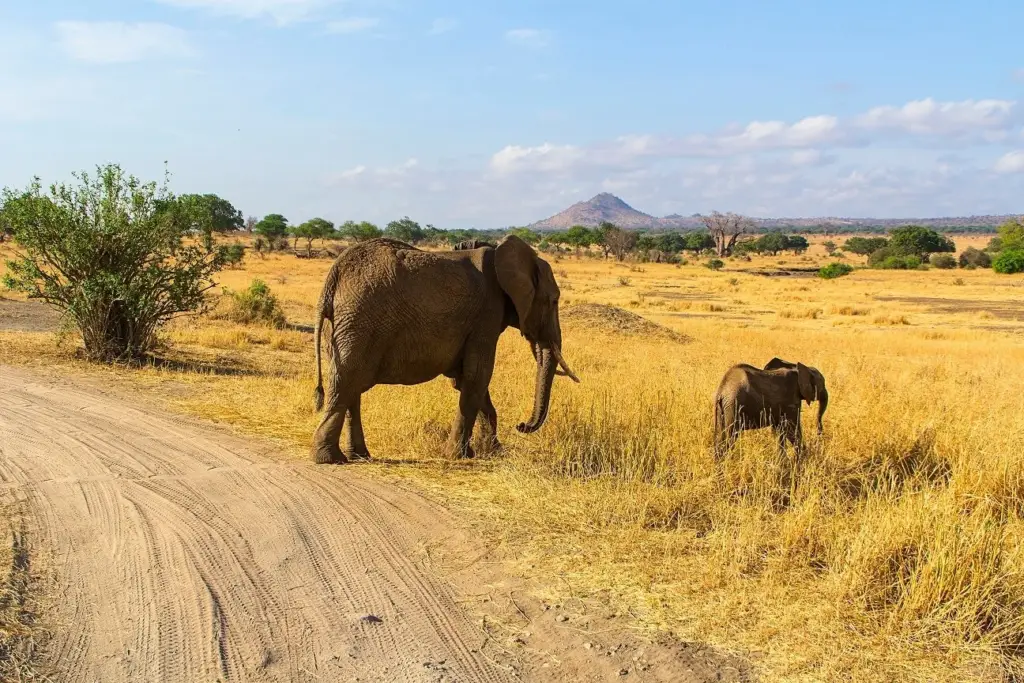Tarangire is often the final stop on a classic northern Tanzania safari route—after exploring Arusha, Lake Manyara, Serengeti, and Ngorongoro—and it’s a place where Tarangire weather plays a big role in shaping the experience. From golden grasslands in the dry season to vibrant greenery during the rains, each season brings its own charm.
It is important to know what the weather is like before planning a trip to Tarangire. The park’s weather can change a lot depending on the time of year. There are dry months when it is easier to see animals around the river and wet months when the park turns green and full of birds.
Understanding the seasonal changes in Tarangire helps travelers to have the best safari experience. Some roads may be harder to drive during the rainy months, while other times offer perfect weather for game drives and photography.
In this article, you will find clear and easy information about the weather in Tarangire National Park so you can plan your visit without any surprises.
General Climate or Tarangire Weather Overview
Tarangire National Park has a tropical savanna climate, which means it has warm temperatures all year round with a mix of dry and rainy seasons. This kind of climate is common in many parts of East Africa.
In Tarangire, you will not find extreme cold or freezing weather as it stays fairly warm and pleasant, though some months are wetter or drier than others.
The average yearly temperature in Tarangire is around 20°C to 30°C (68°F to 86°F). During the day, it can feel quite hot, especially in the dry season. At night, the temperature drops, and it can feel cool, especially in the early morning.
The park receives about 600 to 1,200 mm (24 to 47 inches) of rain each year, mostly falling during the two rainy seasons.
The elevation of Tarangire also affects its weather. The park sits at about 1,000 to 1,500 meters (3,280 to 4,920 feet) above sea level. Because of this height, the air can feel cooler and fresher, especially compared to lower, hotter areas in Tanzania. So, depending on where you are in the park, the weather might feel a bit different.
Seasonal Tarangire Weather Patterns
Tarangire National Park experiences two main seasons each year: the dry season and the wet season. Each season brings its own weather, changes in wildlife behavior, and different things to do. Knowing what to expect in each season can help you plan the best time for your safari.
Dry Season (June to October)
Characteristics
The dry season is the most popular time to visit Tarangire. It starts in June and ends in October. During this time, the skies are mostly clear, and there is very little rain. The landscape turns dusty and dry, and the grass becomes short. This makes it much easier to see animals.
Temperature Ranges
Daytime temperatures stay between 26°C and 30°C (79°F to 86°F). At night and early morning, it can get cool, dropping to about 14°C to 18°C (57°F to 64°F), especially in higher areas. So, a light jacket or sweater is a good idea for morning game drives.
Wildlife Behavior
Since there is less water in the park, many animals gather around the Tarangire River, which flows even during the dry months. You can spot large herds of elephants, zebras, buffaloes, and many types of antelope near the riverbanks. This is also a great time to see predators like lions because they stay close to where prey animals gather.
Best Activities
The dry season is perfect for game drives, wildlife photography, and walking safaris. Since the animals are easier to find and the roads are dry so you can cover more areas of the park comfortably.
Peak Tourist Season Implications
Because the dry season offers the best wildlife viewing so it is also the peak tourist season. This means more visitors and higher prices for park entry, lodges, and tours. If you want a quieter experience, then it is a good idea to book early or choose less crowded areas of the park.
Wet Season (November to May)
Characteristics
The wet season in Tarangire is long and has two rainy periods. The short rains usually come from November to December, and the long rains fall from March to May. In between, especially in January and February, there might be some sunny breaks. The park becomes lush and green, and many trees and flowers bloom.
Temperature Ranges
Temperatures are warm during the day, around 27°C to 30°C (81°F to 86°F). At night, it stays between 16°C to 20°C (61°F to 68°F). Even though it rains but it is not cold, and showers usually come in short bursts, mostly in the afternoon or evening.
Wildlife Behavior
Some animals move out of the park during the wet season, but many still stay. You will see plenty of elephants, giraffes, and other common species. This is also the best time to see baby animals, as many give birth when food and water are plentiful. Also, hundreds of migratory birds arrive, which makes it a bird watcher’s dream.
Best Activities
If you enjoy birdwatching, then this is the perfect season. The green landscape is also beautiful for photography, especially with colorful birds and baby animals all around. However, some roads may get muddy, so a 4×4 vehicle is a must.
Peak Tourist Season Implications
The wet season is considered the low tourist season, except for Christmas and New Year holidays. This means fewer crowds, lower prices, and more peaceful safaris. If you do not mind a little rain and want a quieter experience, then this season can be a great time to visit.
Best Times to Visit Based on Weather
The best time to visit Tarangire National Park depends on what kind of safari experience you want. Since the weather changes throughout the year, some months are better for seeing wildlife clearly, while others are great for enjoying the park’s green beauty and birdlife.
If your goal is to see lots of animals, the best time to visit is during the dry season, from June to October. During these months, the park is dry, and animals gather around the Tarangire River to drink water.
If you enjoy peaceful surroundings, beautiful green views, and birdwatching, then the wet season, from November to May, might be perfect for you. This is when the park turns green, flowers bloom, and baby animals are born. There are fewer tourists, and prices are lower. Just keep in mind that some roads can be muddy and harder to drive on.
Travel Tips Based on Tarangire Weather
When planning your trip to Tarangire National Park, pack your clothes based on the season.
- During the dry season (June to October), bring light clothes for daytime, a hat, sunglasses, sunscreen, and a light jacket for cool mornings.
- In the wet season (November to May), carry a raincoat, waterproof shoes, and a few warm layers for chilly nights.
- A 4×4 vehicle is best during the rainy months, as some roads can be muddy.
- Always carry insect repellent, drink plenty of water, and follow your guide’s advice to stay safe and enjoy your safari.
Final Words
To sum up, the weather in Tarangire National Park has two main seasons: dry and wet. The dry season, from June to October, is great for seeing animals because they gather around water. The wet season, from November to May, brings rain and makes the park look lush while also attracting migratory birds. Knowing the weather patterns will help you to plan your visit and enjoy the park to the fullest, whether you prefer the busy dry season or the calm green months of the wet season.




